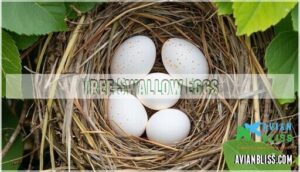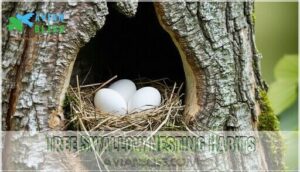This site is supported by our readers. We may earn a commission, at no cost to you, if you purchase through links.

Barn Swallows with their rust-colored throats dart around bridges, while Purple Martins return faithfully to their gourd houses each spring.
Tree Swallows create breathtaking murmurations over marshes during migration, looking like nature’s own synchronized swimming team.
Northern Rough-winged Swallows prefer riverbank hideouts, and Cave Swallows are slowly expanding their territory northward.
These aerial acrobats hunt insects on the wing, nest in everything from mud cups to tree cavities, and migrate thousands of miles with pinpoint precision.
Each species has its own personality and preferred hangout spots that reveal fascinating secrets.
Table Of Contents
- Key Takeaways
- Types of Swallows in Florida
- Characteristics of Tree Swallows
- Tree Swallow Migration and Murmuration
- Tree Swallow Photo Gallery
- Tree Swallow Eggs
- Young Tree Swallows
- Tree Swallow Nesting Habits
- Download Our Bird Guide App
- Tree Swallow Songs and Calls
- Frequently Asked Questions (FAQs)
- Do we have swallows in Florida?
- Why are there lots of swallows flying around?
- Are swallows good to have around your house?
- What’s the difference between a barn swallow and a tree swallow?
- How do swallows help control pest insects?
- What attracts swallows to specific Florida locations?
- When is peak swallow watching season?
- Do swallows return to same nesting sites?
- How can homeowners encourage swallow nesting?
- Conclusion
Key Takeaways
- You’ll find five distinct swallow species in Florida: Barn Swallows with rust-colored throats, Purple Martins (the largest), Tree Swallows with iridescent blue-green backs, Northern Rough-winged Swallows preferring riverbanks, and Cave Swallows expanding their territory northward.
- You can attract swallows to your property by installing nest boxes near water sources, providing mud puddles for nest-building materials, keeping barn doors open, and avoiding pesticides that reduce their insect food supply.
- You’ll witness spectacular murmurations when Tree Swallows gather in massive flocks during migration seasons (late August through May), creating synchronized flight patterns over marshes and coastal areas that help them evade predators and conserve energy.
- You’re getting natural pest control when swallows are around – they consume thousands of mosquitoes, flies, and other insects daily through their aerial hunting skills, making them valuable allies for homeowners without using chemicals.
Types of Swallows in Florida
You’ll find five distinct swallow species that call Florida home throughout different seasons, each with unique characteristics and migration patterns.
Florida’s skies dance with five remarkable swallow species, each bringing their own aerial magic to the Sunshine State.
These aerial acrobats include the rusty-bellied Barn Swallow, the brown Northern Rough-winged Swallow, the iridescent Purple Martin, the mud-nest-building Cave Swallow, and the blue-green Tree Swallow.
Barn Swallow
Spotting a Barn Swallow in Florida’s skies is like watching nature’s aerial acrobat perform. These swallows Florida residents love feature distinctive cobalt blue backs and rusty-orange bellies that make swallow identification easy.
Their deeply forked tails set them apart from other common swallows during birdwatching Florida adventures. For Barn Swallow ID, look for their low-flying hunting style over open fields.
Their nesting behavior involves building mud cup nests under eaves and bridges. Migration patterns bring them through Florida twice yearly, with habitat preferences including agricultural areas and wetlands.
As summer visitors, Cave Swallows nest in Florida. Their conservation status remains stable.
Northern Rough-winged Swallow
Florida’s plainest swallow might fool you with its understated appearance, but the Northern Roughwinged Swallow deserves recognition among Florida bird species.
You’ll spot these 5-6 inch birds displaying solitary behavior while hunting insects over waterways.
Their habitat preference includes open areas near water where nesting cavities in banks or structures provide shelter, and unlike social swallows Florida hosts, rough-wings prefer independence.
For swallow identification, look for their smooth brown backs and light undersides, and adults are easily identified by their brown upperparts.
Their conservation status remains stable, though regional variations exist across their range from Alaska to Central America.
Purple Martin
Looking at North America’s largest swallows, you’ll spot Purple Martins displaying striking size differences.
Males showcase glossy dark purplish-blue plumage while females appear brownish-gray.
These Florida swallows nest exclusively in Martin Housing like gourds and multi-room boxes, creating fascinating Colony Dynamics with their social behavior.
Their Diet Specifics include dragonflies and flying insects caught through aerial acrobatics.
During spring migration, they form impressive Migration Roosts traveling from South America.
To provide adequate nesting, consider martin house options.
Unfortunately, their Conservation Status shows population declines, making suitable nesting sites essential for these remarkable types of swallows.
Cave Swallow
Cave Swallow identification challenges make these chestnut-rumped birds tricky to spot in Florida’s expanding populations.
You’ll find them building distinctive gourd-shaped mud nests under highway bridges and culverts throughout the state.
- Nesting behavior – They construct their mud homes on vertical surfaces, sharing space with bats in caves and man-made structures.
- Cave expansion – Their range has grown dramatically northward over recent decades, establishing new colonies across Florida.
- Conservation status – Despite population growth, hybridization concerns with Cliff Swallows pose potential genetic threats to pure Cave Swallow lineages.
These aerial acrobats migrate to Central America each winter after Florida’s breeding season.
Tree Swallow
While Cave Swallows build their mud masterpieces under bridges, Tree Swallows (Tachycineta bicolor) prefer a different approach to Florida living.
You’ll spot these sleek birds from late August through May, their iridescent blue-green backs catching sunlight as they patrol open areas near water.
Males shine with vibrant plumage variation, while females and juveniles sport more subdued brownish tones.
Tree Swallows excel at winter survival in Florida’s mild climate, though climate impacts are shifting their traditional patterns.
Unlike other swallows, they readily accept nest boxes – your nest box success depends on proper placement near water sources.
These aerial acrobats gather in massive flocks during migration, creating spectacular murmurations over marshes and fields.
For successful birdwatching in Florida, look for Tree Swallows in swallow habitats like wetlands and agricultural areas.
Their chattering calls and graceful flight patterns make them favorites among Florida’s diverse swallows community.
Characteristics of Tree Swallows
You’ll recognize Tree Swallows by their striking iridescent blue-green backs and bright white underparts, making them one of Florida’s most distinctive aerial acrobats.
These streamlined birds measure 5-6 inches long with wingspans reaching 14 inches, and they’re perfectly built for catching insects during their graceful flight patterns over open areas and water sources.
Adult Identification
You’ll recognize adult Tree Swallows by their iridescent blue-green backs contrasting sharply with bright white underparts.
These Florida swallows measure 5-6 inches with distinctive triangular wings and slightly notched tails.
Males display more vibrant plumage variations than females, who often show brownish tones.
Their flight patterns feature graceful swoops and glides, making identification easier during aerial insect hunts.
Seasonal changes affect their coloring intensity, with breeding adults showing the most brilliant blues and greens.
Diet and Behavior
Tree swallows showcase remarkable insect foraging abilities as aerial hunters, consuming roughly 80% insects and 20% fruits annually.
You’ll witness their impressive flight patterns as they snatch flying insects mid-air with precision timing. Their swallow diet includes flies, beetles, winged ants, and spiders caught during acrobatic pursuits.
These insectivorous birds demonstrate fascinating social behavior, gathering in large flocks when not breeding. Their predator avoidance strategies include swift directional changes and group coordination.
During harsh weather, swallow behavior adapts as they switch to consuming bayberries, showcasing remarkable dietary flexibility that sets them apart from other aerial hunters.
Habitat and Nesting Habits
You’ll discover Tree Swallows thriving in Florida’s open fields, meadows, and marshes where water attracts abundant insects.
These cavity-nesters can’t excavate their own homes, so they depend entirely on existing woodpecker holes or nest boxes you provide.
They’re picky about swallow nests, preferring sites 4-6 feet high with clear flight paths.
Habitat Loss threatens their nesting opportunities, making your nest boxes essential for swallow nesting habits.
In Florida bird habitats, they face Nesting Competition from other species seeking the same cavities.
Urban Habitats surprisingly work well when designed properly.
Tree Swallows gather Nesting Materials like grass, feathers, and pine needles to line their homes.
Consider the options for swallow nesting products to enhance their habitat.
Conservation Efforts focus on installing proper nest boxes throughout swallow habitats in Florida, supporting these remarkable aerial acrobats.
Reproduction and Parental Care
Witnessing these aerial acrobats raise their young reveals nature’s dedication in action. Tree swallows demonstrate remarkable parental investment from egg incubation through fledgling development.
You’ll observe both parents sharing responsibilities during the 13-15 day incubation period, with females handling most brooding duties. The nestling diet consists primarily of flying insects, delivered continuously throughout daylight hours.
Parents make hundreds of feeding trips daily, ensuring ideal nutrition for growing chicks. This intensive care directly impacts breeding success rates. Swallows provide natural pest control in the area.
- Egg incubation lasts 13-15 days with females doing most brooding
- Nestling diet includes flies, mosquitoes, flying ants, and small beetles
- Parental care involves both adults sharing feeding and nest defense
- Fledgling development takes 18-22 days before first flight attempts
- Breeding success depends on adequate insect availability and suitable nesting sites
Swallow nests become bustling centers of activity as parents tirelessly nurture their offspring toward independence.
Tree Swallow Migration and Murmuration
You’ll witness Tree Swallows arrive in Florida as early as late August, staying through May as they complete their seasonal migration from northern breeding grounds.
When these birds gather in large flocks, they create spectacular murmurations—synchronized flight patterns that form swirling clouds of wings above marshes and coastal areas.
Explanation of Migration
Swallow migration represents one of nature’s most remarkable journeys, with these aerial acrobats traveling thousands of miles between breeding and Winter Habitats.
Tree swallows cover an average distance of 2,930 kilometers during migration, following established Flyway Routes from North America to Florida, Mexico, and Central America.
Migration Triggers include changing daylight hours and declining insect availability.
Males typically migrate farther than females, showing greater variation in their travel distances.
Climate Impacts increasingly affect timing and routes, while Stopover Ecology plays a vital role – birds spend around 57 days at strategic refueling sites.
Florida serves as both a critical stopover and winter destination for migratory birds in Florida, supporting these incredible long-distance travelers throughout their seasonal journeys.
Murmuration Behavior
Watch Florida’s swallows perform nature’s most mesmerizing spectacle. These aerial acrobats create swirling patterns through Swarm Intelligence, where thousands move as one without a leader. Each bird responds to its nearest neighbors, creating fluid formations that confuse predators and provide Aerodynamic Benefits during flight.
Nature’s aerial ballet unfolds as thousands of swallows dance together in perfect, leaderless harmony across Florida’s evening skies.
Murmuration Origins stem from survival instincts. The key reasons include:
- Predator Evasion – Dense flocks make individual targeting nearly impossible
- Communication Signals – Birds share information about food sources and dangers
- Energy conservation through drafting behind other birds
- Social bonding strengthens flock cohesion
- Ideal roosting site selection through collective decision-making
This bird behavior showcases remarkable coordination among bird species behavior patterns.
Observation by Mary Keith
Mary Keith’s methodology brings scientific rigor to Florida birdwatching through her Board Secretary role at the Florida Birding & Nature Festival.
Her data interpretation of swallow migrations reveals unusual behaviors that casual bird sightings often miss. Keith’s observations document regional differences across Florida’s diverse ecosystems, contributing valuable insights for future research.
Finding the right equipment is easy with a helpful Florida birdwatching guide.
You’ll appreciate her systematic approach to documenting these aerial spectacles:
- Timing Documentation – Recording exact dusk gathering times
- Flight Pattern Analysis – Mapping synchronized movement corridors
- Behavioral Notes – Cataloging predator responses and navigation efficiency
Her work elevates casual birdwatching into meaningful scientific contribution.
Marsh Grass Resting Place
You’ll witness these spectacular murmurations as they descend into Florida’s marsh grass sanctuaries at dusk.
The dense vegetation creates perfect roosting ecology, offering vital predator avoidance from peregrine falcons while supporting social interactions among thousands of swallows.
| Marsh Grass Benefits | Swallow Advantages |
|---|---|
| Dense Coverage | Camouflage from aerial predators |
| Flexible Stems | Comfortable perching without breaking |
| Wetland Location | Abundant insect food sources nearby |
This habitat selection strategy guarantees survival during their northward journey through Florida’s diverse wildlife corridors.
Tree Swallow Photo Gallery
Anyone with a camera knows tree swallows make fantastic photo subjects in Florida. You’ll capture stunning flight poses as these acrobatic birds dart through the air, their iridescent blue-green feathers catching sunlight like jewels.
Males display deeper coloration than females, making identification easier through your lens. Nesting closeups reveal intricate details of their mud-and-grass homes, often built in nest boxes or tree cavities.
Juvenile plumage appears brownish and duller than adults, creating perfect comparison shots for your collection. Habitat views showcase swallows skimming over marshes, fields, and water bodies where insects congregate.
You’ll notice seasonal variations in their behavior—spring brings courtship displays, while fall offers spectacular murmuration photography opportunities. Focus on their distinctive white underparts and streamlined silhouettes during flight.
These Florida residents provide year-round shooting opportunities, whether you’re documenting individual birds or massive flocks preparing for migration. Their predictable flight patterns make them ideal subjects for both beginners and experienced wildlife photographers.
Tree Swallow Eggs
Inside the cozy nest cup, you’ll discover two to eight pristine white eggs adorned with delicate reddish-brown speckles.
This egg coloration helps camouflage them from predators in Florida’s diverse nesting habitats.
The clutch size varies based on food availability and the female’s age, with experienced mothers typically laying more eggs.
During the 13-16 day incubation period, the female rarely leaves her precious cargo, maintaining the perfect temperature for proper development.
The eggshell composition consists of calcium carbonate, which the female obtains from her insect-rich diet and environmental sources.
Like the house sparrow, tree swallow eggs also have unique color patterns, though with different markings.
Tree swallow reproduction in Florida shows impressive hatching success rates when conditions are favorable.
The female’s dedication during incubation directly impacts the survival of future generations, making this phase vital for maintaining healthy swallow populations throughout the state’s varied ecosystems.
Young Tree Swallows
After tree swallow eggs hatch, you’ll witness remarkable fledgling development unfold before your eyes.
These helpless hatchlings depend entirely on their parents for survival in Florida’s nesting sites.
- Eyes closed, ear canals sealed off, helpless.
- Pin feathers emerge, mobility increases.
- Parents constantly bringing insects, removing fecal sacs.
- Hatchlings beg and jostle for position, parents equally attentive.
The altricial young grow rapidly on protein-rich insects. Proximity to food is essential for these nesting birds.
Juvenile plumage appears within days as they prepare for independence. Post-fledging care continues as parents teach essential skills like learning to fly and predator avoidance techniques.
Soon these Florida swallows will master aerial acrobatics, joining massive murmurations during their incredible migrations to warmer climates.
Tree Swallow Nesting Habits
Around your property, Tree Swallows actively search for suitable tree cavities or nest boxes to begin their reproduction cycle.
These birds show strong nest box preferences, selecting sites within 100 yards of open water where insects are plentiful.
Cavity competition with other species like bluebirds can be fierce, so providing multiple nesting options helps guarantee success.
The female constructs her nest using soft grasses, moss, and feathers, creating a cozy cup-shaped structure.
She’ll lay a clutch of 4-7 glossy white eggs, incubating them for approximately 13-14 days.
Both parents share feeding duties once the eggs hatch, delivering insects every few minutes throughout daylight hours.
Fledgling success depends largely on adequate food supply and protection from predators.
These birds often require sturdy support structures for their nests.
Young Tree Swallows typically leave the nest after 18-22 days, though parents continue feeding them for several days post-fledging.
Proper nesting materials and strategic nest box placement substantially improve breeding outcomes.
Download Our Bird Guide App
Florida’s birdwatching enthusiasts will find everything they need in our extensive bird guide app.
You’ll discover detailed species identification tools that make spotting swallows and other Florida wildlife effortless during peak migration seasons.
The app features high-quality photos, authentic bird sounds, and offline access for remote locations where cell service might be spotty.
The app is designed to be user-friendly, making it easy for birders to use.
Community sharing connects you with fellow birders across the state, letting you log sightings and contribute valuable data to conservation efforts.
Whether you’re tracking Barn Swallows near your backyard or Purple Martins at coastal locations, the bird identification guide puts expert knowledge at your fingertips.
App features include interactive maps showing migration patterns, seasonal abundance charts, and detailed habitat information.
You’ll never miss another opportunity to identify Florida’s incredible swallow species as they navigate their remarkable journeys through the Sunshine State.
Tree Swallow Songs and Calls
Beyond downloading apps to identify these feathered performers, you’ll want to tune into their remarkable vocal repertoire. Tree swallows create a symphony that’s both complex and purposeful, with each sound serving a specific function in their daily lives.
Their acoustic communication system includes various bird calls and bird songs that differ from other types of swallows. Males belt out liquid warbles to claim territory, while females respond with softer chittering notes. You’ll notice regional dialects too – Florida tree swallows sound slightly different from their northern cousins.
Listen for these distinct vocalizations:
- Dawn chorus – Melodic warbling that announces sunrise
- Nest relief calls – Sharp chirps when parents switch duties
- Territorial songs – Aggressive trills defending prime real estate
- Contact notes – Quick pips keeping flocks connected
- Alarm calls – Harsh warnings about approaching dangers
The song complexity peaks during breeding season when competition runs high among swallows.
Frequently Asked Questions (FAQs)
Do we have swallows in Florida?
Surprisingly, you’ll spot at least six swallow species across Florida’s skies.
From Barn Swallows with their rusty bellies to Purple Martins, these acrobatic insect-catchers call Florida home year-round or visit seasonally.
Why are there lots of swallows flying around?
You’re seeing swallows because they hunt insects in flight.
During migration seasons, feeding time, or warm weather, they gather in large flocks.
Their acrobatic aerial displays help them catch bugs efficiently.
Are swallows good to have around your house?
Yes, you’ll love having swallows around.
They’re natural pest controllers, devouring thousands of mosquitoes, flies, and other annoying insects daily.
Plus, they’re fascinating to watch with their acrobatic flight patterns and won’t damage your property.
What’s the difference between a barn swallow and a tree swallow?
Barn swallows have deeply forked tails, rusty-orange bellies, and dark blue backs.
Tree swallows sport shorter, square tails with iridescent blue-green tops and pure white undersides.
You’ll spot the difference easily.
How do swallows help control pest insects?
Forget expensive pesticides – you’ve got flying insect vacuums in your backyard! Swallows catch thousands of mosquitoes, flies, and gnats daily while performing aerial acrobatics, naturally controlling pest populations without chemicals.
What attracts swallows to specific Florida locations?
You’ll find swallows flocking to Florida’s open areas near water sources, agricultural fields, and marshes where insects thrive. They’re drawn to bridges, barns, and structures offering perfect nesting spots.
When is peak swallow watching season?
Peak swallow watching happens during spring migration from March through May when species arrive for breeding season.
They also occur during fall migration from August through October when they’re gathering before heading south.
Do swallows return to same nesting sites?
Like creatures of habit, yes, swallows often return to their same nesting sites each year.
You’ll find barn swallows particularly loyal to previous locations, while purple martins religiously come back to established colony sites.
How can homeowners encourage swallow nesting?
You can attract swallows by installing nesting boxes near water sources, leaving barn doors open, providing mud puddles for nest-building.
Avoiding pesticides and maintaining overhangs where they’ll build their cup-shaped homes are also crucial steps in creating an environment that swallows will find appealing.
Conclusion
Armed with this knowledge, you’re now equipped to identify all five swallows in Florida with confidence.
Whether you’re tracking Barn Swallows’ aerial stunts near bridges or witnessing Tree Swallows’ spectacular murmurations over marshes, each species offers unique behaviors worth observing.
These remarkable birds prove that Florida’s skies hold endless surprises for those willing to look up.
So grab your binoculars, head outdoors, and discover why these insect-hunting acrobats make Florida’s bird-watching scene truly extraordinary.









